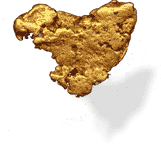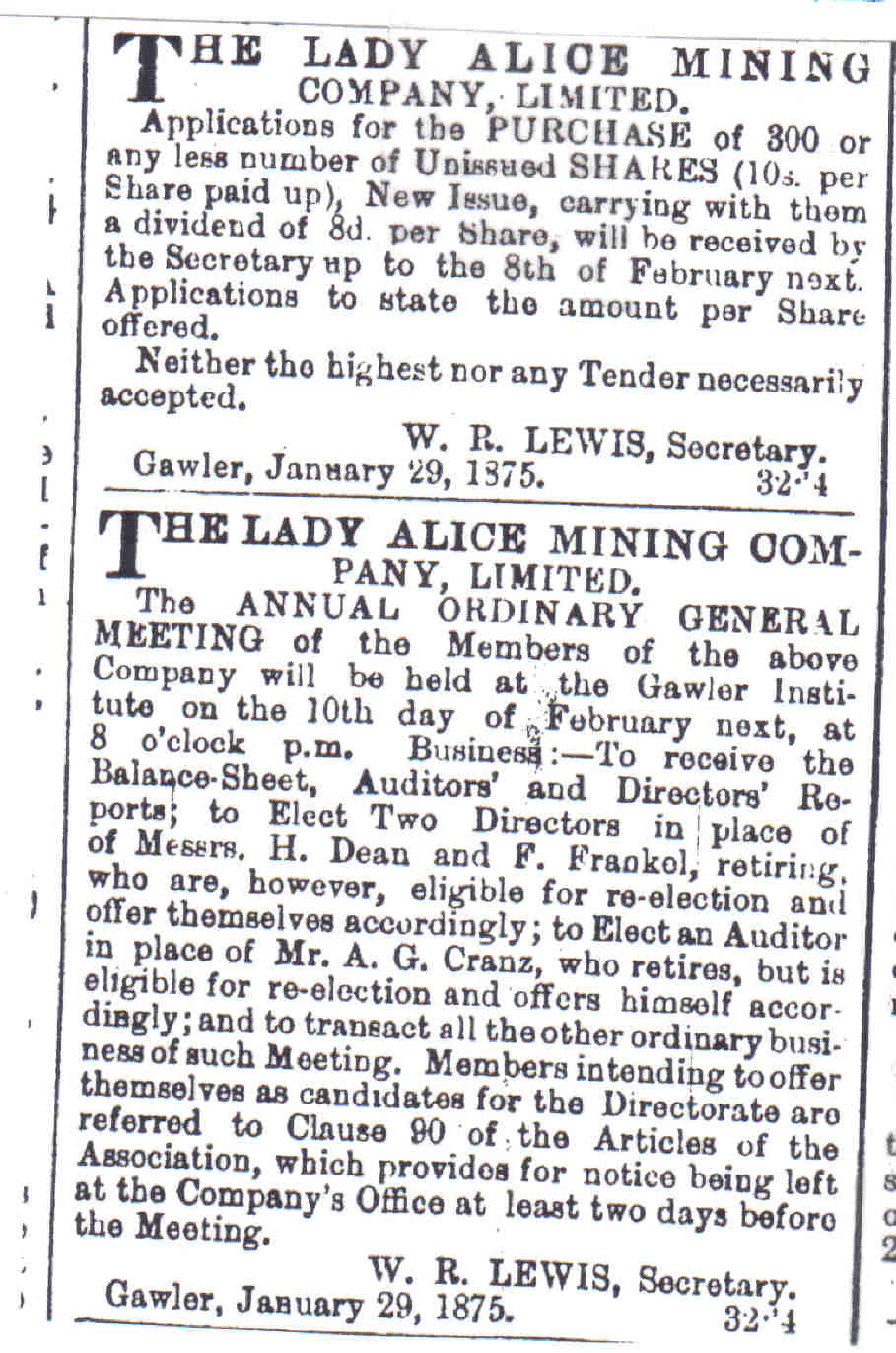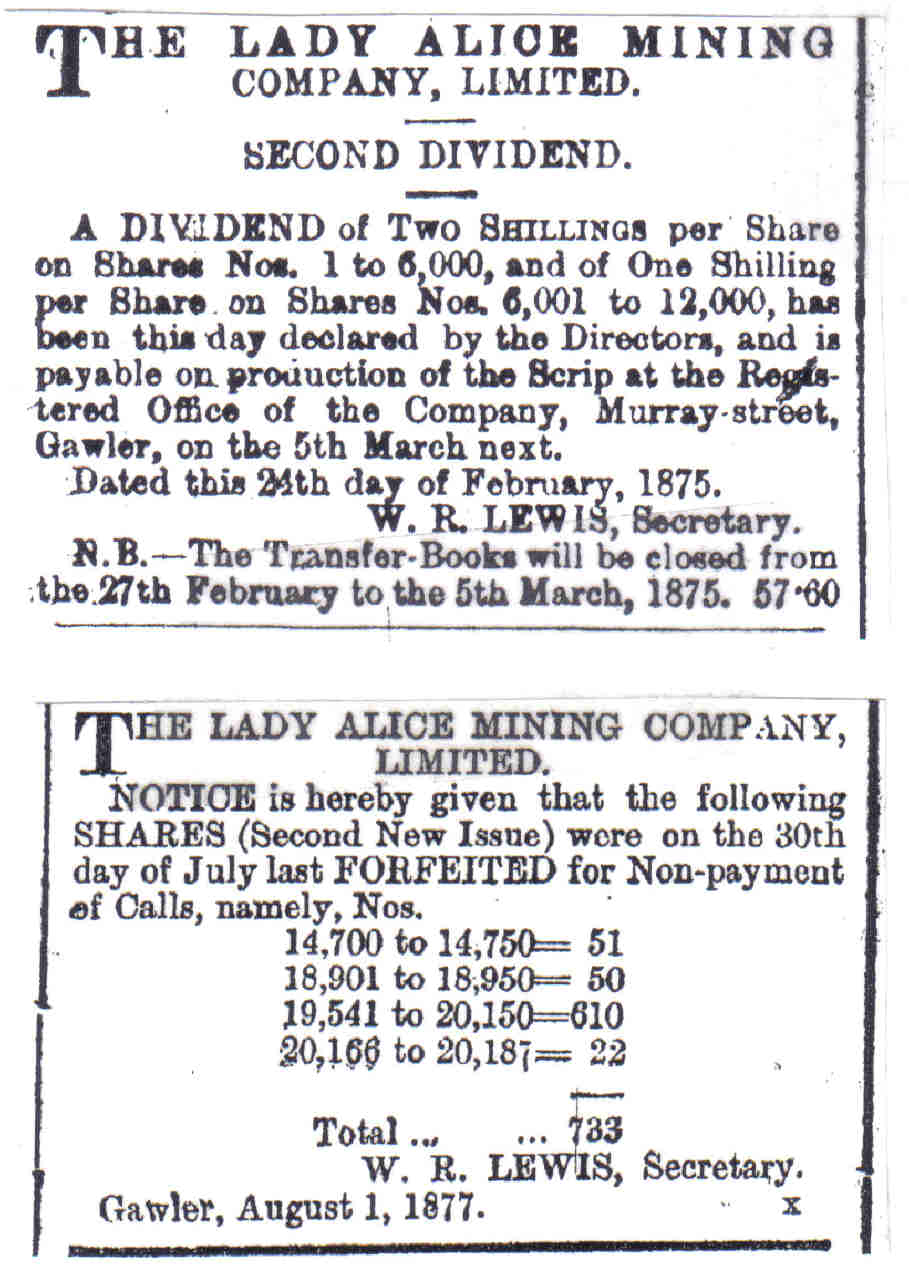


|


Lady Alice Gold Mine |
 |
Lady Alice Notices
After settlement of the Deeds of Association and its incorporation, the Lady Alice directors invited additional tenders for the delivery of brick, lime and stone and for the setting of a boiler and other jobs. The mine attracted a large number of visitors and most who came as sceptics and infidels, returned earnest believers.
Everyone hoped that Goddard, the Ladys industrious and painstaking progenitor, after years of toiling, assisted by his son William, would at last reap a reward. Some of the stone from the quartz reef at the Lady Alice was crushed at James Martins Phoenix Foundry in Gawler with very good and encouraging results.
The company now decided to buy more machinery, including an engine and boiler. A battery of ten heads of stampers was made in Victoria and the company also decided to take up additional claims. More men were put to work on the engine shaft, boiler and engine house and later another 15 men were hired to complete a dam near the mining site.
Captain M Trezise had now taken over from Goddard, as the new directors believed that only a Victorian could work the mine efficiently. Trezise had an engineer and several men working on the new boiler and poppet heads. Near the end of the year everything was in readiness for the stampers, which were arriving from Melbourne.
During August 1873, when many of the miners had settled at Humbug Scrub, the first church service was conducted with about fifty men, women and children attending. Many of these people had not heard a sermon for years. The whole area of Humbug Scrub was improving as well. A small township had developed with a hotel, store and several other buildings. Both a school and chapel were to be built on land donated by the directors of the Lady Alice mine.
This resulted in the Bunyip hoping that they would prosper in their undertaking as the younger branches of the population were badly in need of education. The school was completed by the start of the new school year and A. Hicks started teaching a number of children, some of whom had previously attended the nearby One Tree Hill School.
The proposed Chapel did not eventuate and the Wesleyans conducted their service in the Carpenters shop of the Lady Alice mine. A few weeks later a tender was accepted from B. Symonds for a stone building for the twofold purpose of chapel and school, to be completed in seven weeks. When completed the school remained open until the end of 1877 when teacher George C Fead was transferred to Noarlunga.
At the Lady Alice development continued. It consumed most of the companys capital, leading W Wincey to propose that the balance still outstanding on the shares should be called up. He suggested that three shillings should be called by 21 August 1873 and another five shillings by 20 September. TO Jones supported this view and stated that he would have no objection and was even in favour of increasing the capital.
Early October saw the completion of the dewatering of the old shaft, which had reached a depth of 102 feet, and produced most of the specimens seen in Gawler. The only problem was a shortage of carpenters, causing the completion of the battery to be delayed until Christmas. New Years Day was special that year as the battery was started without any problems. The machinery, which was first class, worked beautifully and a quantity of over 200 tons was crushed.
With most of the problems solved it was decided in January 1874 to extend the drive from the engine shaft to the old shaft in order to drain off the water. The lode increased in size and richness as it went deeper and in most places measured fully seven feet thick. After three weeks crushing, and the cleaning up of the plates the battery had produced 100 ounces of gold.
On 6 January 1874 Captain Trezise gave an extensive report to his directors, which stated that the works at No.1 shaft were progressing satisfactorily. The opening set of timber had been fixed and the second one would go in that day, but it would take another ten days before the chamber was completed.
At No.2 shaft the sinking had been slow but he had succeeded in getting eight feet below the drive. That would be as far as he could go as the inflow of water was increasing all the time. The lode was not only seven feet thick, but full of black ore and some really good payable gold-bearing stone.
To keep up the crushing of about 200 tons of ore he had employed a night shift. Somehow the Captains expectations were not born out as it was not long before they ran out of ore to keep them going and Secretary WR Lewis advertised that the company would be willing to crush quartz for other companies for a short time.
Two months later, on 25 March, an extraordinary meeting was held at the Gawler Institute to act on the suggestion made earlier by Jones to increase the companys capital. It was decided to issue a further 6,000 shares of 1 each. It had also been rumoured that at the completion of the crushing, some 300 ounces of gold had been obtained. However at the meeting, shareholders were told that only 76 ounces had been realised.
Captain Trezise reported that he had been driving from the pump shaft, which had been very hard going, and had only completed about 11 feet. He still had another eight feet to go before it would reach the number two shaft. When completed they would start stoping and build a tramway to the engine shaft. All this digging had provided enough stone to keep the battery going for a further eight days.
In April 1874 the Lady Alice batteries were once again working between twelve and sixteen hours a day to keep up with the supply of ore brought in by the underground trucks. It was confidently predicted that there was enough quartz in view to keep the stampers at work for the remainder of the year yielding an ounce of gold to the ton. There was also a proposal to buy an additional engine to enable the raising and crushing of 30 tons a day, double the present quantity. By the end of May, as many as 506 trucks had been sent to the surface, making a total of 144 tons.
When these 144 tons had been crushed, it produced only 23 ounces of gold. A further 120 tons, crushed a fortnight later, gave a further 50 ounces. When at the end of the month crushing of 71 tons of ore only yielded a meagre 27 ounces, all work in the No 2 shaft was suspended and Goddard was once more asked for help. This time it was decided that the mine would be worked on tribute. From 18 June 1874 the mine was let on tribute to Goddard and Smith for a period of six months, half the proceeds for the company, and the other half for Goddard and Smith.
 |
Lady Alice Notices
No sooner had they started than it was reported that the mine was again the centre of attraction. When Trezise had been in charge hardly any one was to be seen on the mine except the men employed. Now there were shareholders, directors and visitors coming to see the site daily. The tribute arrangement, which would save the company a fair amount of money, also pleased the shareholders.
At the August half yearly meeting, Chairman William Malcolm reported that Goddards first crushing of 75 tons had produced 17 ounces but a second crushing yielded as much as 50 ounces. Just before the meeting Goddard produced the cream on the cake when 145 tons after crushing gave 126 ounces of gold.
One satisfied shareholder later wrote to the local paper that practical results were the best proof of a mans judgement and he thought it only just that James Goddard should get the credit which was due to him by the splendid results he had obtained since taking the mine on tribute. More than 350 ounces had been produced in eight weeks valued at 1,336. This certainly had restored confidence in the mine, which under Captain Trezise, was beginning to assume a very ominous aspect.
While some of the shareholders became jealous of the tributers who were making such good money, they were reminded that after all it was Goddard and his tributers who had saved the company. During their six months contract of 1874 the mine produced more than 1,220 ounces of gold, making a total of 1,913 ounces for the whole year, most of which was sold to Oscar Wehrstedt.
 |
Wehrstedt's cheque butts
Considerable excitement was produced in Gawler by the exhibition in Wehrstedts drapery shop window in Murray Street of a noble cake of gold from the Lady Alice weighing 191 ounces and valued at 731. This splendid sample of what could be done without going to Victoria, the Northern Territory or New Zealand had been the result of ten days work by ten men. Wehrstedt later stated that he had paid the Lady Alice Mining Company 3,086 for gold between 14 September and 22 December 1874.
By October everyone was convinced that it is now proved beyond a doubt that at least one district in South Australia possesses a very rich and payable gold reef, and it is highly probable that more will be found. On 10 November the company was able to pay its shareholders their first dividends. Three days later the Bunyip reported that This Lady has just been doing something that ladies rarely do, namely, doling out dividends to her ardent admirers.
Goddard soon declared that the Lady Alice would prove the richest mine ever opened in South Australia. The Bunyip was more than pleased to report that it was now a case of South Australias shareholders calling at the office for dividends instead of paying calls, an extraordinary occurrence and quite sensational indeed. The Register wrote that the very unusual occurrence in connection with gold mining in South Australia of dividend paying had taken place and found it encouraging seeing fortunate people wending their way to the besieged office of the Lady Alice.
The last crushing at the Lady Alice for 1874 gave a final 40 ounces of gold and it was also the end for the contractors and tributers whose six months had expired. The tributers were more than happy though as they had made on average 7 per week during the last six months. Shareholders were happy too, as the old scrip was still selling in Gawler for 2.16.6 each and the new issue for 1.14.0.
At the start of 1875 the battery worked for nine days straight crushing 110 tons yielding 91 ounces. William Clarke, ex manager of Malcolms mine, had now been appointed manager and made a start with a new engine shaft. The companys directors and Secretary WR Lewis visited the mine and officially installed William Clarke as manager.
They thoroughly examined the whole of the underground workings and were very pleased with the appearance of the different stopes. At the end of their inspection tour, the previous manager, J Tredennick presented them with a cake of 27 ounces of gold. All these good tidings gave fresh vigour to many of the amateur speculators in Gawler.
The next fortnightly crushing yielded a staggering 227 ounces. An ingot of 200 ounces was made from this and displayed at J Williams shop in King William Street Adelaide. Total production for the first six weeks amounted to 542 ounces. At the annual general meeting, held in the Gawler Institute, shareholders were overwhelmed by all the good news.
The chairman of the board, F Makin told them that six months ago the company had liabilities of more than 1,800 whereas now it had a credit balance of 362 after a dividend of 700 had been paid. Very little developmental work had been done during the six months when Goddard and his party worked the mine on tribute. Most of the energy had been expended on mining from the 100 feet level upwards. Between the 50 and 100 feet level stoping was carried northwards looking very well for both copper and gold.
The general appearance of the mine was most promising. It was more than sufficiently timbered but some areas had been left in a very insecure state and would be stoped and filled in as soon as possible. At the end of the meeting CR Roediger and F Frankel were appointed directors. By now everyone was convinced that the Lady Alice had developed to such an extent that it could be regarded, not only as a paying concern, but as an exceedingly rich and productive mine.
Part II
If you would like to find out more,

![]()
![]()
please go
to home page for more information.
Thank you for visiting South Australian History,
We hope you enjoy your stay and find the information useful.
This site has been designed and is maintained by FRR.

